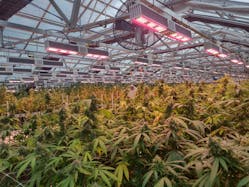LEDs are lighting the way for sustainable cannabis cultivation. They are proven to be more cost-efficient, more environmentally-friendly, and maintenance-free compared to traditional lighting systems that are not only inefficient but are harmful to our planet.
The Guardian recently published a report, “The climate disaster is here1,” ahead of the United Nations Climate Change Conference (COP26)2. The conference brought together government and societal leaders to discuss climate policy.
To put the climate disaster in perspective, The Guardian explains that Earth has “heated up by around 1.2°C, on average, since the pre-industrial era, pushing humanity beyond almost all historical boundaries.1”
The report1 explains that cranking up the heat of the entire planet to this degree in just a century is unfathomable—equating to our oceans being hit with the heat equivalent3 of five Hiroshima atomic bombs every second.
The climate disaster is not coming, it is here now. We need leaders across sectors and industries to realize that we must use every tool at our disposal to minimize our carbon footprint.
Cannabis carbon footprint grows
Innovative high-efficiency lighting technology is here, and continuously being improved, but we need everyone using it — especially when it comes to cannabis cultivation. This industry is as dirty as coal when it comes to carbon footprint. In fact, in Colorado, the cannabis industry emits 30% more carbon than the coal mining industry4.
Per a Colorado State University study5, cannabis cultivation puts out 2.6 metric megatons of carbon dioxide equivalent6 (CO2e), whereas coal is responsible for 1.8 metric megatons.
To put this into perspective, the Colorado study — which was published in the journal Nature Sustainability7 — estimated that growing 1 ounce of cannabis indoors produces as much carbon as burning through a tank of gas8.
Related article: Horticultural SSL market explodes, driven by cannabis greenrush
The startling reality has prompted calls for environmental regulations9 of the cannabis industry similar to that of the energy sector.
Lighting leads the way to energy savings
One simple solution is readily available today: When cannabis cultivators adopted new LED technology, the average energy consumption declined by more than 20% between 2018 and 202010. This means that if the industry were to completely transition to LED lighting, its energy consumption would plummet and its impact on our environment would be drastically improved.
Furthermore, adoption of LED technology makes business sense for the cannabis industry. Higher upfront fixture cost is easily justifiable given the reduction in power usage and the improvement in product quality. California Lightworks provides a simple return on investment (ROI) calculator that demonstrates the typical payback period for a cannabis grower that switches from high-pressure sodium (HPS) to LED-based solid-state lighting is less than 12 months.
Other segments of the lighting market are rapidly transitioning to LED. From 2016 to 2018, “Installations of LED products have increased in all applications, roughly doubling to 2,325 million units or 30.0% of all general illumination lighting,” per the Department of Energy’s (DOE) LED Adoption Report 202011. The DOE also said that LEDs offer the potential for cutting general lighting energy consumption nearly 50% by 203012.
Related article: HortiCann Day 2: Speakers build on business case for LEDs and CEA acumen
Regulatory reform can speed sustainability measures
So what can we do to speed up LED adoption in the cannabis industry? The answer again is simple — regulatory reform. But not the regulations one may expect.
Some local utility companies are providing rebates13 and incentives to encourage cultivators to make the transition to LED lighting systems. Funds for these types of incentives are generally limited, but when they are made accessible, they make a big difference for cultivators and for our environment. We need to expand these types of incentives so cultivators can transition away from traditional HPS systems to LEDs. Superior to these types of incentives, though, would be substantive banking reform.
However, a major economic obstacle still stands in the way of delivering LED efficiency to cannabis grower operations. Under US Federal law, no FDIC-insured bank can finance a cannabis operation. A lack of banking regulatory reform for the cannabis industry is preventing cultivators from getting the financing they need to fully transition and modernize.
The abject lack of banking reform is not only hurting cannabis businesses, but it is hurting our environment, and with the climate disaster here today we can no longer afford to wait for change.
To bring about reform, we need people engaged on the front lines of policy change. That means contacting your lawmakers, both federally and locally. Local policymakers can reach out on your behalf to federal lawmakers. We need to expand support to enact the SAFE Banking Act14. The legislation would guarantee protections to financial institutions that serve state-legal cannabis businesses.
The SAFE Banking Act was successfully added to the National Defense Authorization Act (NDAA) of 202215 by its sponsor Colorado Democratic Rep. Ed Perlmutter and is likely to be passed in December.
Additionally, on a grassroots level, support advocacy groups like the Washington, DC-based National Cannabis Industry Association (NCIA) and National Organization for the Reform of Marijuana Laws (NORML). And, of course speaking out on social media and in your community to encourage others to join will go far in advancing change.
Get to know our expert
GEORGE MEKHTARIAN is the chief executive officer of California Lightworks, an LED manufacturer that has proudly helped reduce 465,813 metric tons of CO2 emissions.
REFERENCES
1. O. Milman, A. Witherspoon, R. Liu, and A. Chang, “The climate disaster is here,” The Guardian (Oct. 14, 2021).
2. United Nations Climate Change Conference (COP26).
3. I. Kottasová, “Oceans are warming at the same rate as if five Hiroshima bombs were dropped in every second,” CNN (Jan. 13, 2020).
4. D. Avery, “When going green is dirty,” Daily Mail (Mar. 10, 2021).
5. A. Manning, “Insatiable demand for cannabis has created a giant carbon footprint,” Colorado State University engineering news (Mar. 8, 2021).
6. J. Quinn and H. Summers, “Growing cannabis indoors produces a lot of greenhouse gases — just how much depends on where it’s grown,” The Conversation (Mar. 8, 2021).
7. H.M. Summers, E. Sproul, and J.C. Quinn, “The greenhouse gas emissions of indoor cannabis production in the United States,” Nature Sustainability, 4, 644-650 (2021).
8. A. Fox, “Growing an ounce of pot indoors can emit as much carbon as burning a full tank of gas,” Smithsonian Magazine (Mar. 15, 2021).
9. S. Gill, “Budding marijuana industry meets climate & environmental crisis: A call to legislative action,” Oil and Gas, Natural Resources, and Energy Journal, Vol. 5, No. 4 (April 2020).
10. N. Fertig and G. Bade, “An inconvenient truth (about weed),” Politico (Aug. 10, 2021).
11. US Department of Energy Office of Energy Efficiency & Renewable Energy, “Adoption of light-emitting diodes in common lighting applications” (August 2020).
12. US Department of Energy Office of Energy Efficiency & Renewable Energy, Building Technologies Program, “Energy savings potential of solid-state lighting in general illumination applications” (January 2012).
13. California Lightworks blog, “Get a utility rebate by using LEDs instead of HPS lighting” (Aug. 28, 2020).
14. H.R.1996 — SAFE Banking Act of 2021, 117th Congress (2021–2022).
15. J. Schroyer, “SAFE Banking status: Q&A with marijuana industry ally US Rep. Ed Perlmutter,” MJBizDaily (Nov. 8, 2021).
*Editor's note: An abridged version of this contributed article appears in the January/February 2022 issue of LEDs Magazine.
For up-to-the-minute LED and SSL updates, why not follow us on Twitter? You’ll find curated content and commentary, as well as information on industry events, webcasts, and surveys on our LinkedIn Company Page and our Facebook page.






